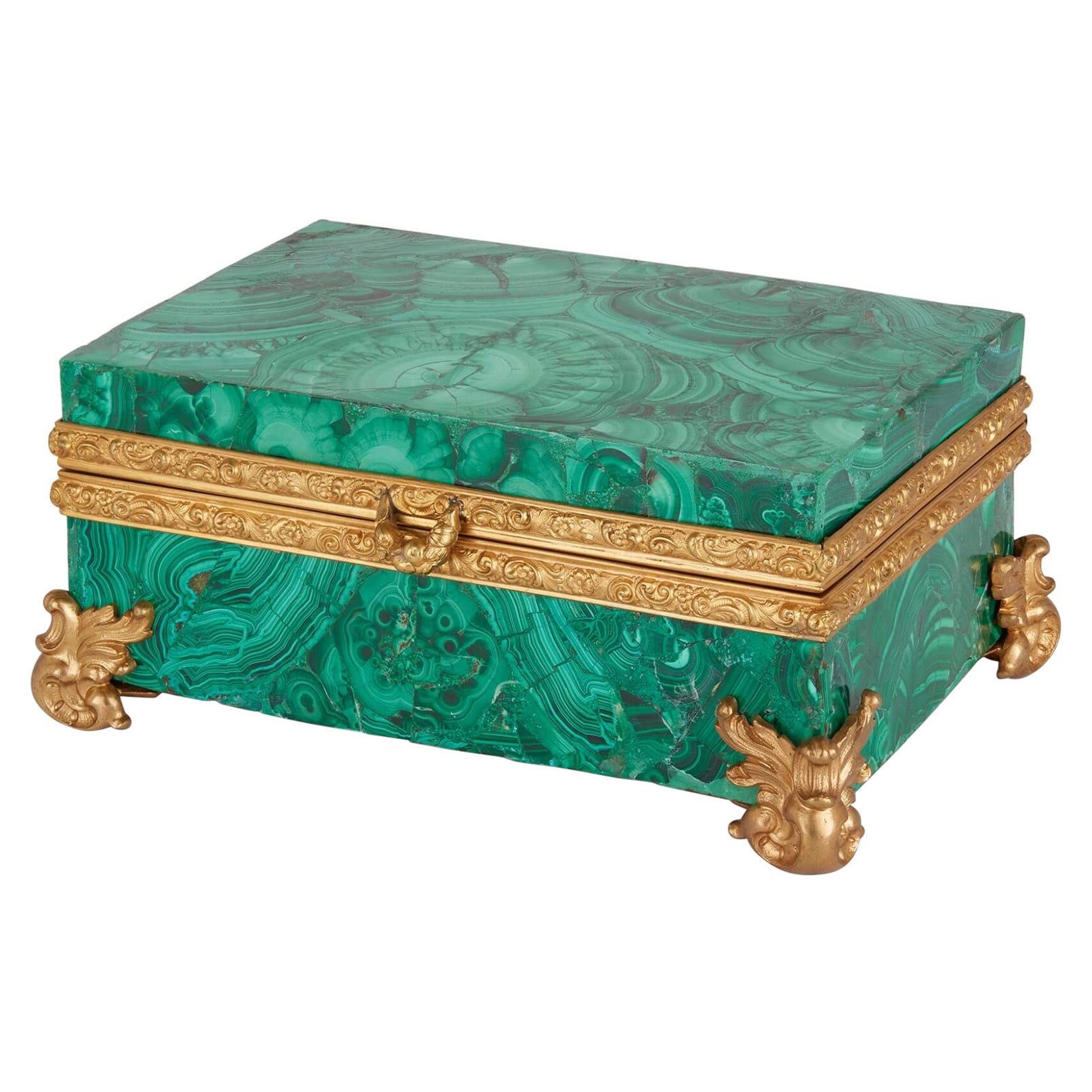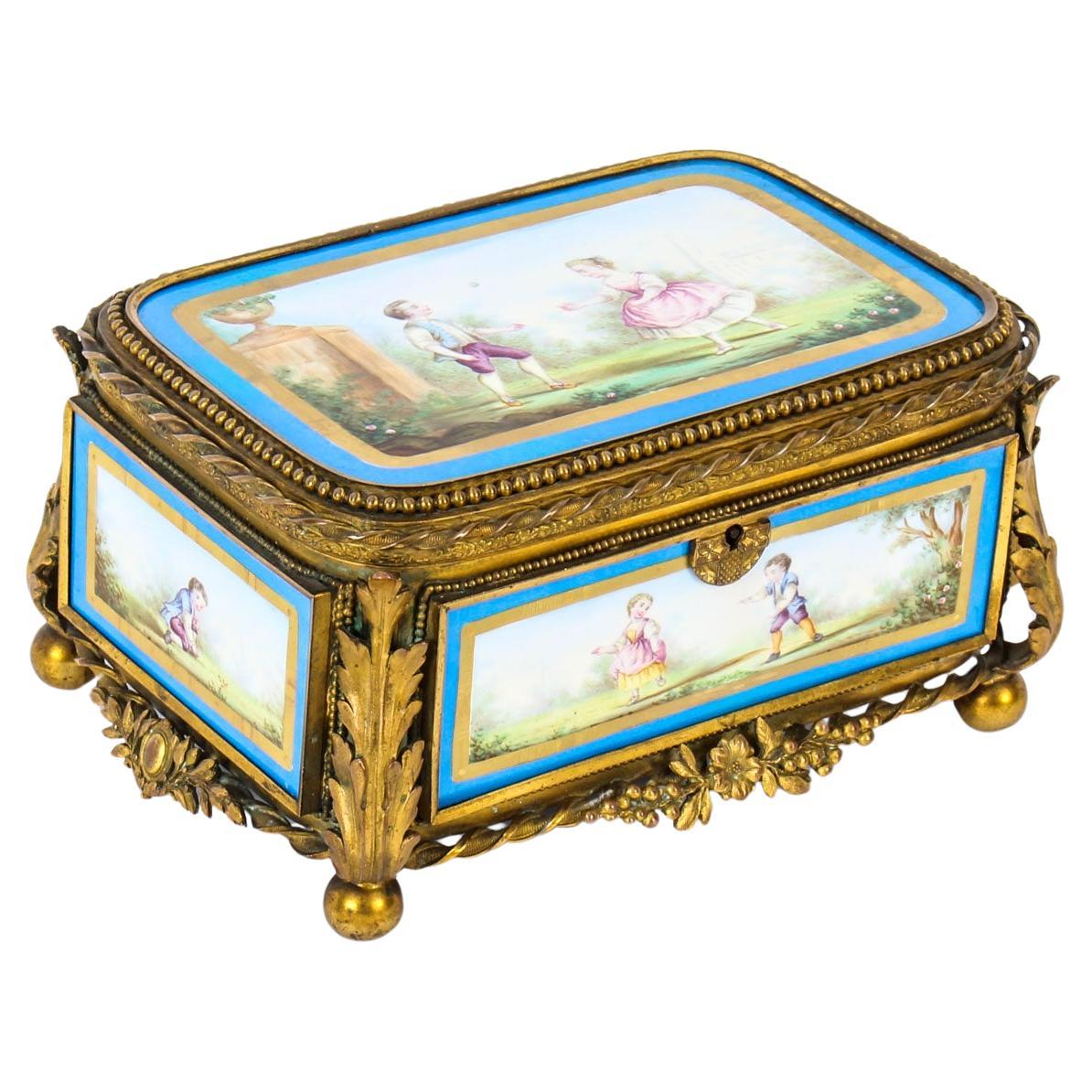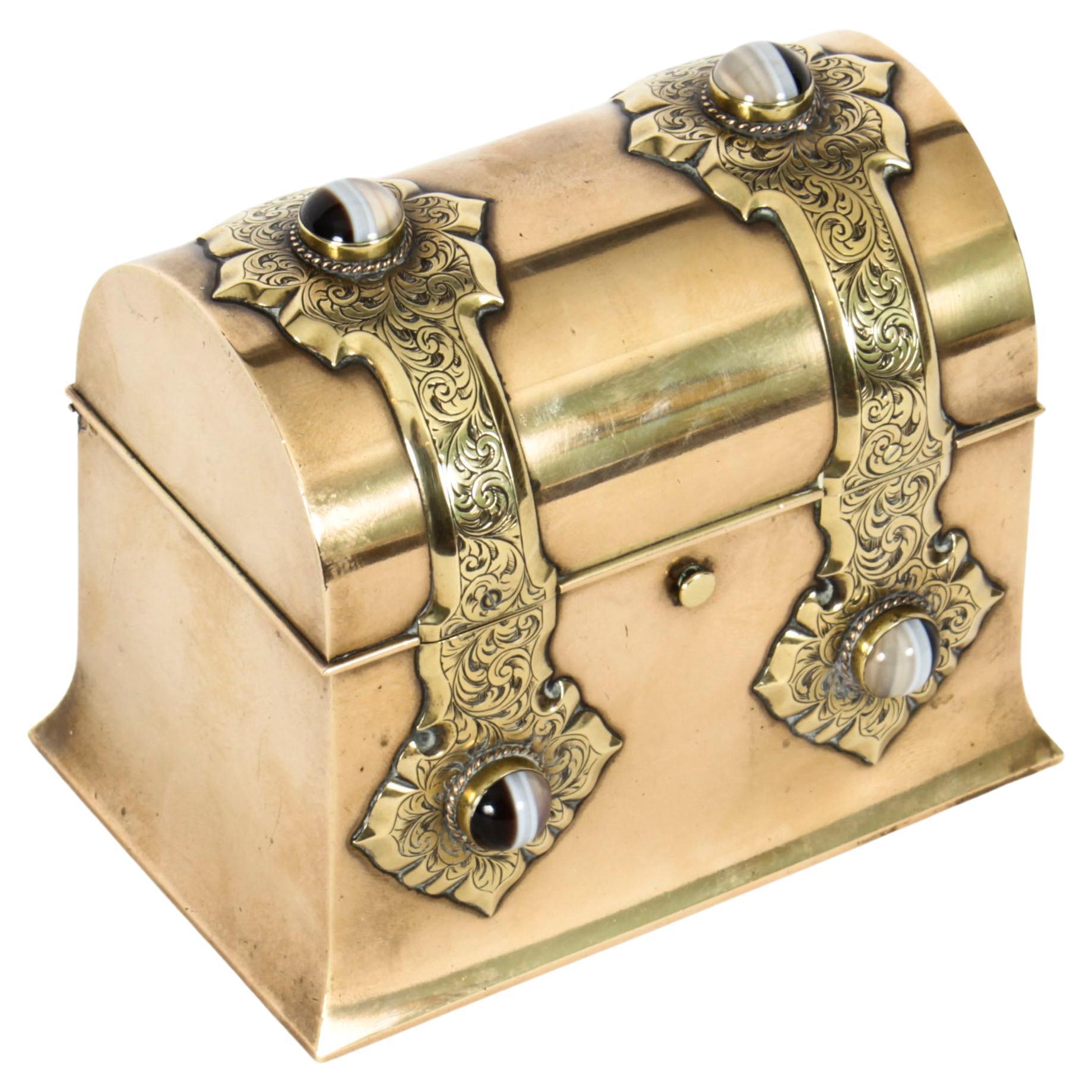Items Similar to Antique French Marquetry and Ormolu Stationary Casket . 19th Century
Want more images or videos?
Request additional images or videos from the seller
1 of 20
Antique French Marquetry and Ormolu Stationary Casket . 19th Century
About the Item
This is a wonderful antique French Gonçalo Alves marquetry and ormolu mounted casket, circa 1860 in date.
The casket of bureau form has a lift up top and is inlaid with a marquetry flower vase which opens to a plain interior lined with marbled paper, above a single drawer with conforming marquetry front and sides, and raised on a shaped plinth base with decorative acanthus ormolu mounts.
It has fully working locks and is complete with its original key.
This is a highly decorative casket which will make a statement once placed on any period desk.
Condition:
In really excellent condition, please see photos for confirmation.
Dimensions in cm:
Height 21 x Width 30 x Depth 22
Dimensions in inches:
Height 8 inches x Width 1 foot x Depth 9 inches
Gonçalo Alves is a hardwood (from the Portuguese name, Gonçalo Alves). It is sometimes referred to as tigerwood — a name that underscore the wood’s often dramatic, contrasting color scheme.
While the sapwood is very light in color, the heartwood is a sombre brown, with dark streaks that give it a unique look. The wood’s color deepens with exposure and age and even the plainer-looking wood has a natural luster.
Two species are usually listed as sources for gonçalo alves: Astronium fraxinifolium and Astronium graveolens, although other species in the genus may yield similar wood; the amount of striping that is present may vary.
In the high tropical forests of Central and South America, well-drained soils furnish nutrients for a variety of dense, durable hardwoods sought for maritime use, heavyconstruction, and furniture. The Spanish began harvesting in Latin American forests in the early 1500s to provide timber for boatbuilding and repair. By the early 1900s, however, steel ships had replaced wooden ones, and the interest in tropical forests by both Europeans and Americans shifted to appearance-grade woods for furniture.
Although history fails to provide us with a shopping list of species from either harvest period, it's probable that the wood we know today as goncalo alves has always been sought. That's because goncalo alves, considered one of the most beautiful of tropical woods, has a tough reputation, too. Strong and durable, it's used for construction in its homeland and secondarily for fine furniture. Woodworkers elsewhere treasure the wood for decorative items and veneer accents.
Marquetry
is decorative artistry where pieces of material of different colours are inserted into surface wood veneer to form intricate patterns such as scrolls or flowers.
The technique of veneered marquetry had its inspiration in 16th century Florence. Marquetry elaborated upon Florentine techniques of inlaying solid marble slabs with designs formed of fitted marbles, jaspers and semi-precious stones. This work, called opere di commessi, has medieval parallels in Central Italian "Cosmati"-work of inlaid marble floors, altars and columns. The technique is known in English as pietra dura, for the "hardstones" used: onyx, jasper, cornelian, lapis lazuli and colored marbles. In Florence, the Chapel of the Medici at San Lorenzo is completely covered in a colored marble facing using this demanding jig-sawn technique.
Techniques of wood marquetry were developed in Antwerp and other Flemish centers of luxury cabinet-making during the early 16th century. The craft was imported full-blown to France after the mid-seventeenth century, to create furniture of unprecedented luxury being made at the royal manufactory of the Gobelins, charged with providing furnishings to decorate Versailles and the other royal residences of Louis XIV. Early masters of French marquetry were the Fleming Pierre Golle and his son-in-law, André-Charles Boulle, who founded a dynasty of royal and Parisian cabinet-makers (ébénistes) and gave his name to a technique of marquetry employing brass with pewter in arabesque or intricately foliate designs.
Ormolu - Gilt Bronze (from French 'or moulu', signifying ground or pounded gold) is an 18th-century English term for applying finely ground, high-carat gold in a mercury amalgam to an object of bronze.The mercury is driven off in a kiln leaving behind a gold-coloured veneer known as 'gilt bronze'.
The manufacture of true ormolu employs a process known as mercury-gilding or fire-gilding, in which a solution of nitrate of mercury is applied to a piece of copper, brass, or bronze, followed by the application of an amalgam of gold and mercury. The item was then exposed to extreme heat until the mercury burned off and the gold remained, adhered to the metal object.
Our reference: A3376
- Dimensions:Height: 8.27 in (21 cm)Width: 11.82 in (30 cm)Depth: 8.67 in (22 cm)
- Materials and Techniques:
- Period:
- Date of Manufacture:Circa 1860
- Condition:
- Seller Location:London, GB
- Reference Number:
About the Seller
5.0
Platinum Seller
These expertly vetted sellers are 1stDibs' most experienced sellers and are rated highest by our customers.
Established in 1983
1stDibs seller since 2012
1,199 sales on 1stDibs
Typical response time: <1 hour
Associations
LAPADA - The Association of Arts & Antiques Dealers
- ShippingRetrieving quote...Ships From: London, United Kingdom
- Return PolicyA return for this item may be initiated within 14 days of delivery.
More From This SellerView All
- Antique French Sevres Porcelain and Ormolu Jewellery Casket 19th CenturyLocated in London, GBThis is a fabulous antique French Ormolu and Sevres Porcelain jewellery casket, circa 1860 in date. This magnificent casket is rectangular in shape with the top and each side except...Category
Antique 1860s Jewelry Boxes
MaterialsOrmolu
- Antique Ormolu & Agate Mounted Casket by Asprey, 19th CenturyLocated in London, GBThis is a superb antique gilt bronze and agate mounted casket by Asprey, Circa 1870 in date. The casket features a rectangular outline with domed lid which opens to reveal two clear glass scent bottles. It is stamped Charles Asprey, 166 Bond Street, Provenance: Lady Elizabeth Prinfle Lady in waiting to Queen Victoria, lived at Bonchurch, Isle of Wight It is a lovely piece which will make an unforgettable gift. Condition: In excellent condition having been beautifully cleaned in our workshops, please see photos for confirmation. Dimensions in cm: height 10.5 x width 12.5 x depth 7.5 Dimensions in inches: height 4 inches x width 5 inches x depth 3 inches Asprey was established in England in 1781 and founded as a silk printing business by William Asprey, it soon became a luxury emporium. In 1841, William Asprey's elder son Charles went into partnership with a stationer located on London's Bond Street. In 1847 the family broke with this partner and moved into 167 New Bond Street, the premises Asprey occupies today. From its central London location Asprey advertised 'articles of exclusive design and high quality, whether for personal adornment or personal accompaniment and to endow with richness and beauty the table and homes of people of refinement and discernment.' An early speciality was dressing cases. Asprey crafted traditional cases and designs, mostly in leather, suitable for the new style of travel ushered in by railways. The main competitors at the time were H.J. Cave & Sons. Asprey was recognised for its expertise when it won a gold medal for its dressing cases at the International Exhibition of 1862 but lost out to its rivals, H.J. Cave & Sons in 1867. The company consolidated its position through acquisitions. In 1859 Asprey absorbed Edwards, an award winning maker of dressing cases and holder of a Royal Warrant. The company also purchased the Alfred Club at 22 Albemarle Street, which backed on to the New Bond Street store and meant that Asprey now had entrances on two of London's most fashionable streets. In 1862, Asprey was granted a Royal Warrant by Queen Victoria. The Prince of Wales, later to be crowned Edward VII, granted another Royal Warrant. In 1953, for the coronation of Elizabeth II, Asprey paid homage with the Asprey Coronation Year Gold Collection, which featured a dessert, coffee and liqueur service in 18-carat gold and weighed almost 27 pounds. In April 1953, it went on show in the New Bond Street store and subsequently toured the United States. As the business grew, the company acquired manufacturing facilities and hired silversmiths, goldsmiths, jewellers and watchmakers including Ernest Betjeman, the father of the distinguished poet John Betjeman, one of the most highly regarded craftsman and designers of his day. In the twenties, commissions poured in from around the world, from American millionaire J. Pierpont Morgan to potentates such as the Maharaja of Patiala, who commissioned a huge teak travelling trunk for each of his wives in which each trunk was fitted with solid silver washing and bathing utensils with waterspouts of ornate tiger head and lined with blue velvet. Asprey cigarette cases became collectable amongst young sophisticates who delighted in its other modern products, including travel clocks, safety razors and automatic pencil sharpeners. Asprey Jewellery Asprey has a tradition of producing jewellery inspired by the blooms found in English gardens. Over the decades jewelled interpretations of flowers have evolved to include the Crown Daisy, Rose, Calla Lily and Lily Pad collections. The master diamond cutter Gabi Tolkowsky created the Asprey cut. The cushion cut gave Tolkowsky options for incorporating the Asprey "A" inscription around the edges of the stone. The result was the 61-facet Asprey cut, maximising light refraction to brilliant effect. The shape of the Asprey cut means that the cutting process can be done only by hand, unlike many other stones that involve machine cutting. Asprey Leather - the women's collection of clutches and handbags, such as those featured in the 1781 collection, come from crocodile, python and ostrich. The men's collection includes wallets, cardholders and travel watch cases crafted from lido, calf or alligator. Other items include the briefcases and backgammon boards. Asprey Silver - offers classic and whimsical contemporary silver pieces – such as the saltcellar fashioned to look like a cement mixer...Category
Antique 1870s English Decorative Boxes
MaterialsAgate, Ormolu
- Antique Figured Coromandel Brass Box / Casket 19th CenturyLocated in London, GBThis is a magnificent antique brass bound coromandel Victorian Gothic Revival casket by Parkins and Gotto, 24 & 25 Oxford Street, London, circa 1860 in date. The rectangular box fe...Category
Antique 1860s English Victorian Decorative Boxes
MaterialsBrass
- Antique Huge French Amboyna Porcelain Cameo Writing Casket 19th CLocated in London, GBA French ormolu and porcelain cameo mounted amboyna writing box, circa 1860 in date. The rectangular casket features a lid with a central floral hand painted porcelain panel, cross...Category
Antique 1860s Decorative Boxes
MaterialsOrmolu
- Antique French Silvered Copper Jewellery Casket Box B Wicker 19th CLocated in London, GBThis is a beautiful Antique silvered copper French Jewellery Casket, engraved by by the famous French engraver B.Wicker, Paris C 1880's. This...Category
Antique 1880s French Jewelry Boxes
MaterialsCopper
- Antique Limoges Royal Blue Ormolu Mounted Casket Box 19h CenturyLocated in London, GBThis is a beautiful antique French Limoges ormolu mounted rectangular bombe' shaped table casket, circa 1870 in date and bearing the Limoges marks on the underside. The Royal Blue c...Category
Antique 1870s French Decorative Boxes
MaterialsOrmolu
You May Also Like
- Antique 19th Century Malachite and Ormolu CasketLocated in London, GBAntique 19th century malachite and ormolu casket Russian, Mid-19th Century Height 9cm, width 21cm, depth 15cm This magnificent malachite casket celebrates the work of 19th century ...Category
Antique Mid-19th Century Russian Decorative Boxes
MaterialsMalachite, Ormolu
- 19th Century French onyx + ormolu jewellery casket.Located in Brighton, SussexA very good quality French 19th Century onyx, ormolu mounted jewellery casket, having Pietra dura floral plaques to each corner, set into classically shaped gilded ormolu mounts. Ba...Category
Antique Late 19th Century French Jewelry Boxes
MaterialsOnyx, Ormolu
- A 19th Century Marquetry Italian Letter CasketLocated in Lincolnshire, GBA fine quality marquetry inlaid walnut and olive wood Italian letter or paper box, the shaped top lid with a pastoral scene and shepherdess. Circa 1870Category
Antique 19th Century Italian Decorative Boxes
MaterialsOlive, Walnut
- 19th Century French Art Nouveau Enameled Ormolu Jewel CasketLocated in Forney, TXAn exceptional Belle Époque period French artisan-crafted enameled jewel casket. Born in the late 19th century, having a square beveled and etched butterf...Category
Antique 19th Century Belle Époque Jewelry Boxes
MaterialsMetal, Ormolu
- French 19th Century Silver Plated CasketLocated in London, GBThe whole casket is richly decorated. Standing on lions paw feet adorned with baroque motifs the scene on top depicts cupid stood beside two lovers (possibly) Daphne and Apollo. The ...Category
Antique 19th Century French Jewelry Boxes
MaterialsSilver Plate
- 19th Century Sevres CasketBy Manufacture Nationale de SèvresLocated in London, GBA rare antique French gilt bronze and silver Sevres porcelain casket finely painted with neoclassical figures on two round and two rectangular ...Category
Antique Late 19th Century French Decorative Boxes
MaterialsCeramic
Recently Viewed
View AllMore Ways To Browse
Italian Wood Box Antique
18th Century Marble Desk
Metal Antique Locks Keys
18th And 19th Centuries American Boxes
Portuguese Bureau
European Wooden Box
French Bedroom Marquetry
Antique Drawer Locks
Bronze Gilt Box France
Brass Marble Antique Objects
Cabinet English Louis
Mid Century Marble Box
Louis Xiv Cabinet Boulle
Timber Plinth
Will Pewter
Antique French Ormolu Light
Pierre Boulle Furniture
Pewter Boxes Antique





